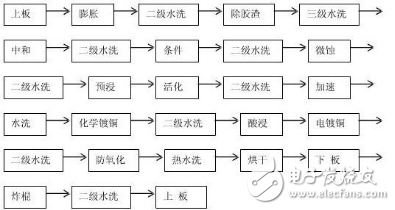Detailed analysis of environmental advantages based on polymer conductive film
The PCB hole metallization process is one of the processes that produce the most wastewater. The complex copper ion wastewater produced by the traditional PTH process is the most difficult to handle. The large amount of formaldehyde used is very harmful to the field workers, and a large amount of organic wastewater needs to be treated. Compared with the traditional PTH process, Saikeite polymer conductive film has significant environmental advantages.
Comparison of water consumption and energy consumption: Secort selected a PTH and polymer conductive film customer to make a comparison of water and electricity consumption. The amount of wastewater required for conventional PTH and full-plate plating is 72.2 liters/square meter, and the amount of wastewater required for Sectech polymer conductive film and selective plating is 48.2 liters/square meter. This means that the amount of wastewater generated by the Sectech polymer film is 30% less than that of the conventional process; while the power consumption of the conventional process is 2.9 degrees per square meter, and the customer of the same size polymer film The power consumption per square meter is 2.15 degrees, which means that the use of polymer conductive film can reduce more energy consumption.
Comparison of wastewater categories: The wastewater produced by the traditional PTH process has complexed copper ion wastewater, organic wastewater, and a large amount of formaldehyde-damaging chemicals. Among them, complexed copper ion wastewater is more difficult to handle. The complex copper ion is not produced in the process of the Sectech polymer conductive film, and the use of sodium permanganate is relatively easy to reduce. The rest of the organic wastewater treatment process is much simpler.
Comparison of Wastewater Treatment Costs: According to customer sampling, Secort's traditional PTH process plus selective plating water consumption is about 30-40% higher than that of Sectech polymer film. This means that not only the cost of water is saved, but also the environmental treatment cost of the generated wastewater.
Using the most economical energy consumption and less water to treat each square meter itself is a contribution to society. Environmental protection is the trend of the times. The use of polymer conductive film is more suitable for environmental protection, and further saves costs, protects employees' health and improves The efficiency. It can be said that it is more than one thing.

"Non-burning, nicotine for users, low tar content. As the heating temperature (below 500℃) is lower than the combustion temperature of traditional cigarettes (600-900℃), the harmful components produced by tobacco high-temperature combustion pyrolysis and thermal synthesis are reduced, and the release amount of side-flow smoke and environmental smoke (second-hand smoke) is also greatly reduced."
Heating non - combustion products are electronic devices containing tobacco. When you heat them, they produce a nicotine-containing vapor that you can inhale.
They are different from traditional cigarettes and work by heating tobacco to a very low temperature. Tobacco is heated to 350 ° C in a heat-incombustible device, while traditional cigarettes burn at up to 900 ° C.
Still, the temperature at which non-combustion products are heated is high enough to vaporize and inhale harmful chemicals.
Although both are electronic devices, heated non-combustible products are also different from e-cigarettes or steam devices. These usually use chemical liquids and do not necessarily contain nicotine. E-cigarettes tend to heat liquids to around 250 degrees Celsius to produce vapor.
Hnb Device Oem,Hnb Device Patent,Hnb Device,Hnb Device For Sale
Shenzhen MASON VAP Technology Co., Ltd. , https://www.disposablevapepenfactory.com
